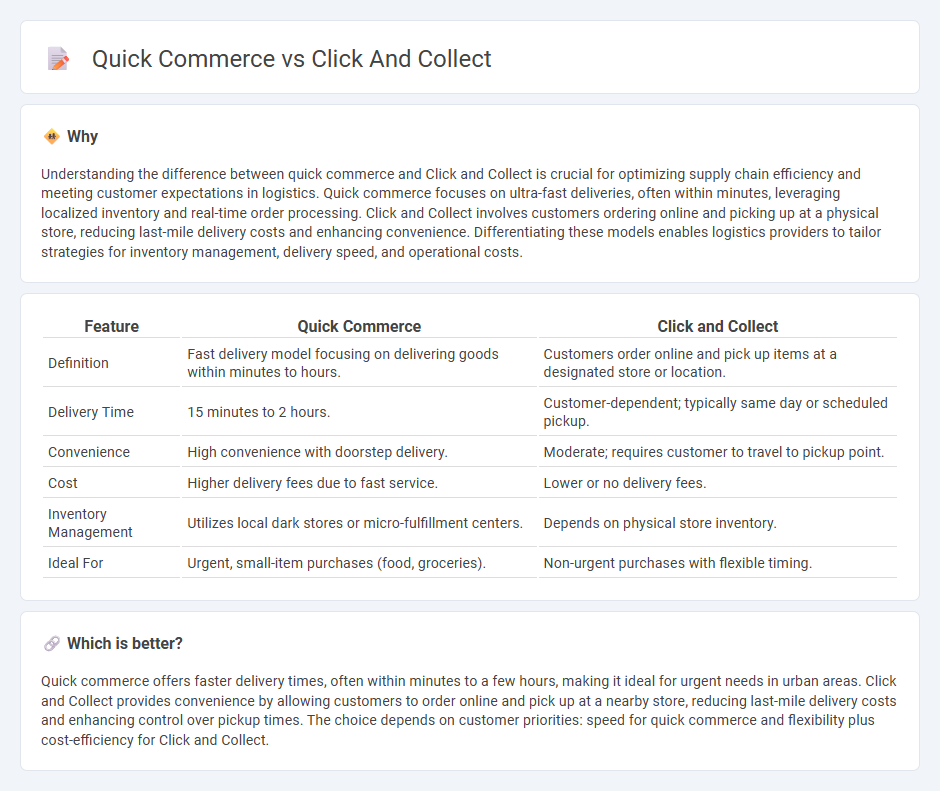
Quick commerce ensures ultra-fast delivery often within minutes, leveraging localized micro-fulfillment centers and real-time inventory management to meet urgent consumer demands. Click and Collect combines online ordering with in-store pickup, reducing delivery time and shipping costs by enabling customers to retrieve products at their convenience from physical retail locations. Explore how these distinct logistics models are revolutionizing customer experiences and supply chain efficiency.
Why it is important
Understanding the difference between quick commerce and Click and Collect is crucial for optimizing supply chain efficiency and meeting customer expectations in logistics. Quick commerce focuses on ultra-fast deliveries, often within minutes, leveraging localized inventory and real-time order processing. Click and Collect involves customers ordering online and picking up at a physical store, reducing last-mile delivery costs and enhancing convenience. Differentiating these models enables logistics providers to tailor strategies for inventory management, delivery speed, and operational costs.
Comparison Table
| Feature | Quick Commerce | Click and Collect |
|---|---|---|
| Definition | Fast delivery model focusing on delivering goods within minutes to hours. | Customers order online and pick up items at a designated store or location. |
| Delivery Time | 15 minutes to 2 hours. | Customer-dependent; typically same day or scheduled pickup. |
| Convenience | High convenience with doorstep delivery. | Moderate; requires customer to travel to pickup point. |
| Cost | Higher delivery fees due to fast service. | Lower or no delivery fees. |
| Inventory Management | Utilizes local dark stores or micro-fulfillment centers. | Depends on physical store inventory. |
| Ideal For | Urgent, small-item purchases (food, groceries). | Non-urgent purchases with flexible timing. |
Which is better?
Quick commerce offers faster delivery times, often within minutes to a few hours, making it ideal for urgent needs in urban areas. Click and Collect provides convenience by allowing customers to order online and pick up at a nearby store, reducing last-mile delivery costs and enhancing control over pickup times. The choice depends on customer priorities: speed for quick commerce and flexibility plus cost-efficiency for Click and Collect.
Connection
Quick commerce relies heavily on efficient click and collect systems to minimize delivery times and enhance customer convenience, enabling shoppers to order online and pick up items swiftly from nearby locations. Integrated inventory management and real-time tracking in logistics ensure seamless coordination between fulfillment centers and retail outlets, reducing last-mile delivery challenges. This synergy between quick commerce and click and collect optimizes supply chain agility and meets rising consumer demand for rapid and flexible purchasing options.
Key Terms
Fulfillment Center
Click and Collect relies on strategically located fulfillment centers to enable customers to order online and pick up their purchases in-store, reducing last-mile delivery costs and wait times. Quick commerce emphasizes ultra-fast delivery by operating micro-fulfillment centers close to densely populated urban areas, ensuring orders reach customers within minutes. Explore the detailed differences in fulfillment center roles for optimized retail strategies.
Last-Mile Delivery
Click and Collect services streamline last-mile delivery by enabling customers to pick up online orders from designated locations, reducing delivery time and costs. Quick commerce emphasizes ultra-fast home delivery, often within minutes, leveraging micro-fulfillment centers and advanced logistics technology to meet urgent consumer demands. Explore the evolving dynamics of last-mile delivery to discover which model best suits your business needs.
Order Aggregation
Order aggregation plays a crucial role in both Click and Collect and quick commerce by consolidating multiple customer orders to streamline the fulfillment process and increase efficiency. In Click and Collect, this method optimizes store pickup experiences by grouping orders for faster preparation, while quick commerce leverages aggregation to accelerate delivery times through efficient batch processing of orders. Explore our detailed analysis to understand how order aggregation transforms retail logistics and enhances customer satisfaction.
Source and External Links
What is Click & Collect - How to Improve Retail Strategy? - Click and collect is a retail service where customers order items online and then pick them up at a physical store or collection point, offering convenience and control over order pickup location and timing, with models including in-store (BOPIS) and third-party pickup points.
What is Click & Collect? Benefits to retailers & consumers - Click & collect (BOPIS) allows consumers to shop online and collect items in-store or at curbside pickup, reducing delivery costs and offering same-day convenience, a rapidly growing channel that enhances both customer experience and retailer efficiency.
Click & Collect 101: What Is It and How Does It Work? - Click and collect refers to online purchase with in-store or curbside pickup, where customers order online, store employees prepare orders, and customers either enter the store or use curbside delivery, a popular option boosted by the COVID-19 pandemic for safe, convenient shopping.
 dowidth.com
dowidth.com